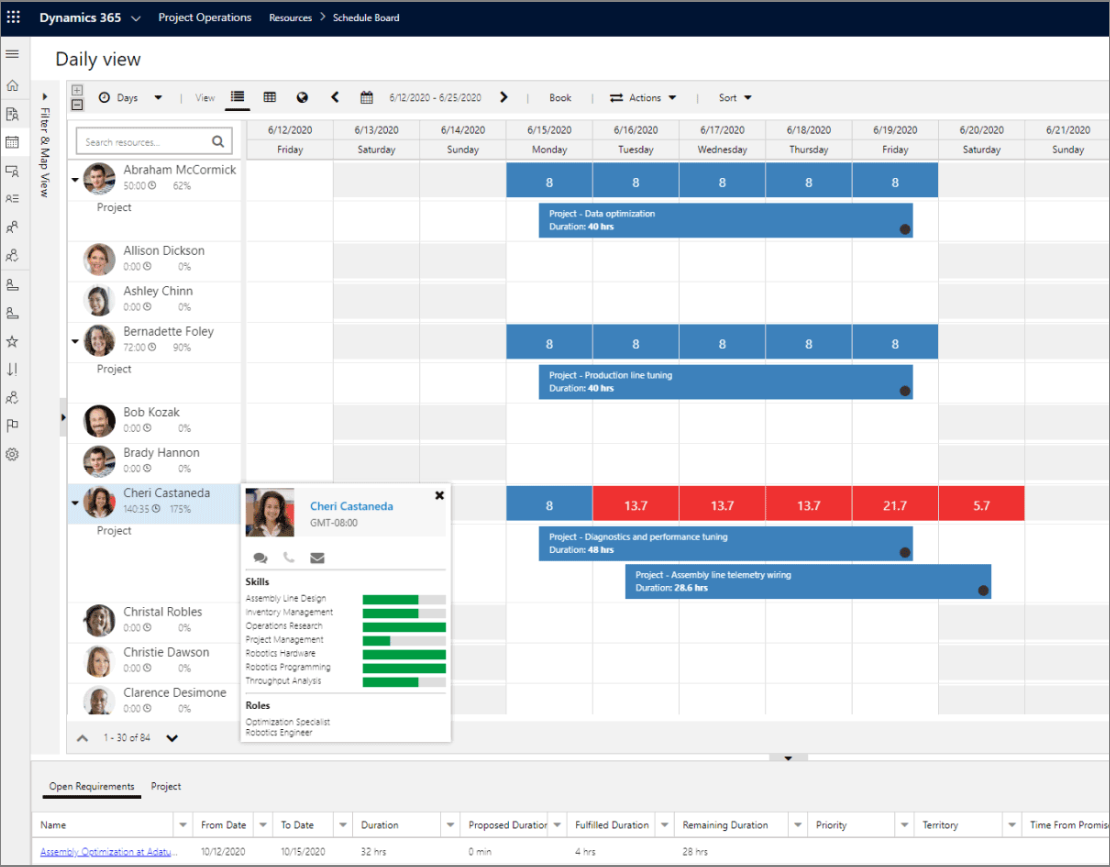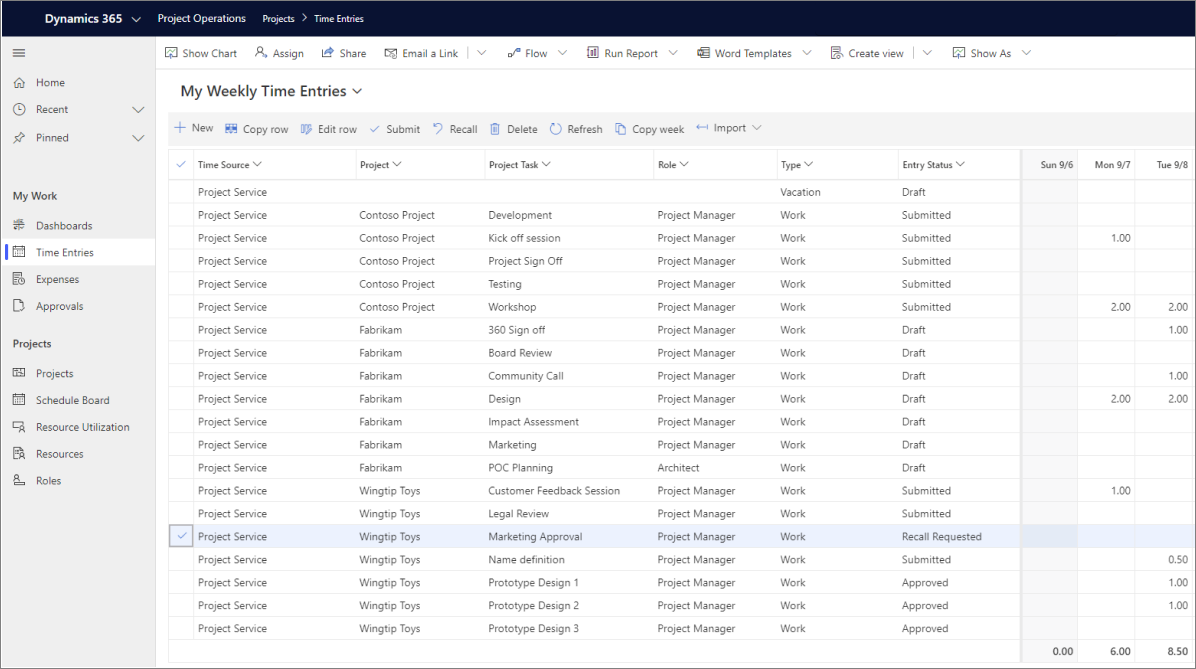Overview of Project Operations features
Project Operations offers the following feature areas.
Opportunity management
The following features support opportunity management in Project Operations:
- Customize resource-based costing and pricing – Model robust pricing and costing variations based on geography and local market economics that influence your global workforce and exchange rates.
- Use deal structures that are tailored for project-based organizations – Create fixed-price, time and materials, and retainer-type contracts for your projects by using adaptable billing models that meet your customers’ cash-flow requirements.
- Flexible pricing and more accurate quotes – After generating a high-level estimate, use standardized templates to quickly develop a detailed estimate, schedule, and monetary values for the quote.
- Sales pipeline management and a unified sales dashboard – Combine customer data from different sources into a single view by connecting to Dynamics 365 Sales. Use the intuitive and flexible customer data platform to get actionable insights and create personalized customer experiences.
Enhanced project management capabilities
The following features support the enhanced project management capabilities in Project Operations:
- Project management tools – Improve productivity with embedded Microsoft Project capabilities, including accessible dashboards, task management, scheduling, interactive Gantt charts, and work-breakdown structures.
- Track your projects efficiently – Develop accurate estimates for labor, expenses, and materials, and track planned-to-actual consumption as projects progress. Use built-in insights to understand how your projects are trending and drive timely decisions for course correction.
- Teamwork with Microsoft Teams – Collaborate across the project life cycle by bringing your cross-functional teams together around project plans, scope, and budget while capturing conversations, sharing content, and using apps all in one place.
- In-depth project execution tools and upkeep – By using catalogs, contracts, and views into the actual expenses, time spent, and materials, you can enforce contractual rules and commitments to accurately track up-to-date progress towards spend, revenue, and schedule targets.
Resource scheduling and assignments
The following features support resource scheduling and assignments in Project Operations:
- Maximize your resource use – Distribute workloads equally across your resources for optimal implementation on project delivery needs.
- Align the right people with the right skillsets to the right projects – Maintain resource profiles to match people with projects. Rate skills with proficiency models that adapt to your business needs.
- Anticipate resourcing needs with intelligent scheduling – Streamline scheduling with intelligent and relevant skills-based assignments and up-to-date information about resources’ availability by using Universal Resource Scheduling.
- Manage resources across your organization – Universal Resource Scheduling integrates with other Dynamics apps, such as Field Service and Customer Service, to allow booking of resources in an all-up view.
Simplify time tracking and expense management
The following features support simplified time tracking and expense management in Project Operations:
- Intuitive time entry – Team members capture time through an intuitive time entry grid that allows them to enter time in a weekly view, add time from their bookings or their assignments, or to copy past time entries.
- Submit time and expenses on the go – Use the mobile app or a browser for time and expense submissions, no matter your location. Automatically create expense lines from uploaded receipt images by using Optical Character Recognition (OCR) capabilities.
- Ensure accurate reporting and approvals – Maintain complete visibility and control of your organization’s expenses by using policies, approvals, and reporting. Submit, approve, process, and reconcile time and expenses anytime and anywhere.
- Unify your time and expense processes – Track expenses in different currencies while integrating with project accounting, payroll, and invoicing for a comprehensive experience.
Streamlined project financials
The following features support streamlined project financials in Project Operations:
- Recognize revenue accurately and on time – Promote best practices and support global teams by following published accounting standards and practices by using built-in multicurrency, project financials, and revenue recognition that is compliant with International Financial Reporting Standards (IFRS).
- Invoice customers quickly and more precisely – Manage billing queues and add impromptu transactions more effectively for invoicing. Tailor customer invoices by choosing style and design, adding details, and grouping transactions for optimal review and reconciliation.
- Higher accuracy project accounting – Use project cost and revenue profiles for fixed-price or time and material billing through a combination of accounting rules for cost and revenue, accruals, and postings. Quickly review project statements and forecast cash flow to get in-depth project financial information.
- Expand to a service-centric enterprise resource planning (ERP) system – Use the built-in integration with Dynamics 365 Finance or use open APIs with an external ERP system to extend to accounts payable, accounts receivable, and general ledger capabilities.
Analytics and integrations
The following features support accurate analytics, reporting, and insights:
- Accurate analytics presented in interactive dashboards – By using the integrations to Dynamics 365 Finance, dashboards can be created to manage and track all project actions and analytics
- Financial event and statement reports – Access to all pieces of the project operations platform, integration with other products result in more accurate and available financial event predictions and detailed statement reporting.
- Business intelligence-based action plans and follow-up - Interacting and building business intelligence reports using Power BI and the integrations afforded by the power platform can help create action plans and how to follow through with AI insights.



